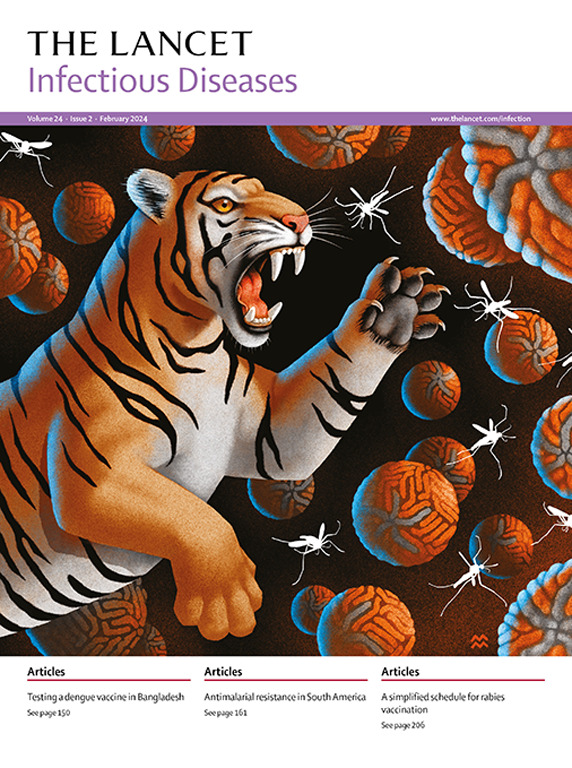中国新出现的蜱媒叶佐病毒感染者系列:主动监测和基因组分析
IF 36.4
1区 医学
Q1 INFECTIOUS DISEASES
引用次数: 0
摘要
背景叶佐病毒(YEZV)是一种新出现的蜱媒病原体,最初于 2021 年在日本报告。迄今为止,中国仅报告过一名患者。我们的目的是描述一系列患者的流行病学、临床和实验室结果,并描述 YEZV 病毒基因组的特征。方法在这次主动监测和基因组分析中,我们在中国东北黑龙江省牡丹江林业中心医院进行了主动监测。在2022年和2023年的5月1日至7月31日期间,以及在2024年的5月1日至7月10日期间,因近期被蜱虫叮咬而就医的参与者均符合纳入条件。我们采集了参与者的血清,通过元转录组测序、实时 RT-PCR 和间接免疫荧光法检测 YEZV 感染情况。我们通过细胞培养分离了 YEZV,并通过形态学和系统发育分析确定了病原体的特征。研究结果 在 988 名参与者中发现了 18 名 YEZV 感染患者(12 名男性,6 名女性;中位年龄 53 岁,IQR 45-60)。患者表现为发热(18 名患者,100%)、头痛(10 名患者,56%)、头晕(9 名患者,50%)、乏力(3 名患者,17%)、腰痛(3 名患者,17%)和咳嗽(3 名患者,17%)。九名患者(50%)在蜱虫叮咬部位周围出现皮疹,四名患者(22%)出现淋巴结病。九名患者(50%)有胃肠道症状,五名患者(28%)有神经系统症状。在 16 名接受评估的患者中,我们观察到 10 人(63%)出现白细胞减少症,5 人(31%)出现血小板减少症。在所有18名患者中,有13人(72%)肝脏转氨酶浓度升高,9人(50%)乳酸脱氢酶或α-羟丁酸脱氢酶升高,13人(72%)血清淀粉样蛋白A升高,10人(56%)超敏C反应蛋白升高。从参与者身上取下的 119 只 Ixodes persulcatus 蜱虫中,有 8 只(7%)对 YEZV 呈阳性反应。从患者血清中分离出三种 YEZV 株系。从五名患者、从一名参与者身上取下的一只吸血蜱,以及在发现患者的地区或邻近地区采集的四只宿主蜱样本中获得了十个病毒基因组。系统发生学分析表明,患者或蜱虫体内的YEZV分为两个支系,每个支系都有不同的变异。本文章由计算机程序翻译,如有差异,请以英文原文为准。
A series of patients infected with the emerging tick-borne Yezo virus in China: an active surveillance and genomic analysis
Background
Yezo virus (YEZV) is an emerging tick-borne pathogen, which was initially reported in Japan in 2021. Only one patient had been reported in China so far. We aimed to describe the epidemiological, clinical, and laboratory findings of a series of patients, and to characterise the viral genomes of YEZV.Methods
In this active surveillance and genomic analysis, we conducted active surveillance at Mudanjiang Forestry Central Hospital, Heilongjiang Province of northeast China. Participants were eligible for inclusion if they sought medical care for a recent tick bite between May 1 and July 31, in 2022 and 2023, and between May 1 and July 10, in 2024. We collected sera from participants to detect YEZV infection by meta-transcriptomic sequencing, real-time RT-PCR, and indirect immunofluorescence assay. We isolated YEZV by cell culture and characterised the pathogen by morphological and phylogenetic analyses.Findings
A series of 18 patients with YEZV infection (12 male and six female; median age 53 years, IQR 45–60) were identified among 988 participants. The patients presented with fever (18 patients, 100%), headache (ten patients, 56%), dizziness (nine patients, 50%), malaise (three patients, 17%), lumbago (three patients, 17%), and cough (three patients, 17%). Nine (50%) patients had rash around the tick bite site and four (22%) had lymphadenopathy. Nine (50%) patients had gastrointestinal symptoms, and five (28%) had neurological symptoms. We observed leukopenia in ten (63%) and thrombocytopenia in five (31%) of 16 assessed patients. Elevated hepatic transaminase concentrations were identified in 13 (72%) of all 18 patients, lactate dehydrogenase or α-hydroxybutyric dehydrogenase in nine (50%), serum amyloid protein A in 13 (72%), and hypersensitive C-reactive protein in ten (56%). Eight (7%) of 119 Ixodes persulcatus ticks removed from participants were positive for YEZV. Three YEZV strains were isolated from the sera of patients. Ten viral genomes were obtained from five patients, a blood-sucking I persulcatus removed from a participant, and four host-questing tick samples collected in the areas where patients were identified or in the adjacent region. Phylogenetic analyses revealed that YEZVs in either patients or ticks were divided into two clades, each with distinct mutations.Interpretation
Awareness of YEZV infection is important and clinicians should consider the virus when diagnosing patients with suitable symptoms.Funding
National Key Research and Development Program of China.Translation
For the Chinese translation of the abstract see Supplementary Materials section.求助全文
通过发布文献求助,成功后即可免费获取论文全文。
去求助
来源期刊

Lancet Infectious Diseases
医学-传染病学
CiteScore
60.90
自引率
0.70%
发文量
1064
审稿时长
6-12 weeks
期刊介绍:
The Lancet Infectious Diseases was launched in August, 2001, and is a lively monthly journal of original research, review, opinion, and news covering international issues relevant to clinical infectious diseases specialists worldwide.The infectious diseases journal aims to be a world-leading publication, featuring original research that advocates change or sheds light on clinical practices related to infectious diseases. The journal prioritizes articles with the potential to impact clinical practice or influence perspectives. Content covers a wide range of topics, including anti-infective therapy and immunization, bacterial, viral, fungal, and parasitic infections, emerging infectious diseases, HIV/AIDS, malaria, tuberculosis, mycobacterial infections, infection control, infectious diseases epidemiology, neglected tropical diseases, and travel medicine. Informative reviews on any subject linked to infectious diseases and human health are also welcomed.
 求助内容:
求助内容: 应助结果提醒方式:
应助结果提醒方式:


